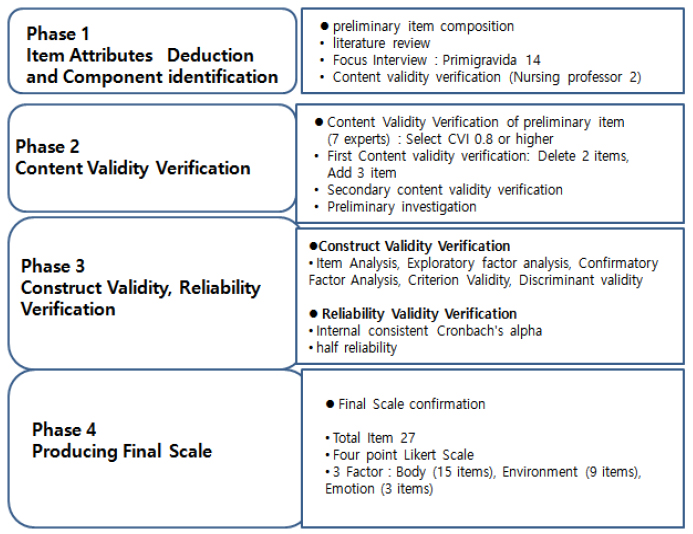Korean J Women Health Nurs.
2018 Sep;24(3):297-309. 10.4069/kjwhn.2018.24.3.297.
Development of Pregnancy Risk Symptom Perception Scale
- Affiliations
-
- 1Assistant Professor, Department of Nursing, Cheongam College, Suncheon, Korea.
- 2Professor, College of Nursing, Institute of Health Science, Gyeongsang National University, Jinju, Korea. css4214@gnu.ac.kr
- KMID: 2420851
- DOI: http://doi.org/10.4069/kjwhn.2018.24.3.297
Abstract
- PURPOSE
To develop Pregnancy Risk symptom Perception Scale (PRPS) and evaluate its validity and reliability.
METHODS
A preliminary 30-item version of PRPS was developed through literature review, in-depth interview, and Content Validity. Each item was scored on a four-point Likert scale. The preliminary scale was developed based on 301 pregnant women who visited a hospital. Date were analyzed using item analysis, factor analysis, confirmatory factor analysis, Pearson's correlation coefficients, and Cronbach's α (0.90 for total item, 0.80 to 0.88 for factors).
RESULTS
The PRPS consisted of 27 items. Three factors (physical, environmental, and emotional factors) explained 55% of the total variance. Cronbach's Criterion validity was supported by comparison with the Perception of Pregnancy Risk Questionnaire (r=0.34). In reliability test, the reliability coefficient of pregnancy risk symptom perception was high at 0.90.
CONCLUSION
These results suggest that the pregnancy risk symptom perception scale developed in this study comprises items that can assess the level of pregnant women's pregnancy risk symptom perception in Korea. Its validity and reliability were proven. PRPS can be utilized to measure pregnant women's risk symptom perception during pregnancy. PRPS will contribute to the development of systematic prenatal care and effective risk management.
Keyword
MeSH Terms
Figure
Reference
-
1. Whang RI, Kim GH, Youn JW, Lee JS. The trend of national health insurance service use among pregnant and postpartum women aged 35 years and older. Korean J Health Policy Adm. 2011; 21(4):585–598. DOI: 10.4332/KJHPA.2011.21.4.585.2. Choi JH, Han HJ, Hwang JH, Chung SR, Moon H, Park MI, et al. Meta analysis of clinical studies of pregnancy and delivery in elderly gravida. Korean J Obstet Gynecol. 2006; 49(2):293–308.3. Lee SS, Kim DH, Kim TH. Fertility differentials by demographic and socioeconomic characteristic: Analysis of Korean population census data. Korea J Popul Stud. 2006; 29(1):1–23.4. National Statistical Office. Birth Statistics 2016 [Internet]. Seoul: Statistics Korea;2017. cited 2017 August 29. Available from: http://www.kostat.go.kr/portal/korea/kor_nw/2/1/index.board?bmode=read&aSeq=362574.5. Lee JY, Choi US. Stress and coping style of high-risk pregnant women's spouses. Korean J Women Health Nurs. 2010; 16(3):234–244. DOI: 10.4069/kjwhn.2010.16.3.234.
Article6. Kim SM, Kim DS. The effect of parental socioeconomic position on the association between birth outcomes and infant mortality in Korea: Focusing on early and late 2000's. Korea J Popul Stud. 2012; 35(1):131–149.7. Salem Yaniv S, Levy A, Wiznitzer A, Holcberg G, Mazor M, Sheiner E. A significant linear association exists between advanced maternal age and adverse perinatal outcome. Arch Gynecol Obstet. 2011; 283(4):755–759. DOI: 10.1007/s00404-010-1459-4.
Article8. Kim TE, Lee SP, Park JM, Whang BC, Kim SY. The effects of maternal age on outcome of pregnancy in healthy elderly primipara. Korean J Perinatol. 2009; 20(2):146–152.9. Carolan MC. Towards understanding the concept of risk for pregnant women: Some nursing and midwifery implications. J Clin Nurs. 2009; 18(5):652–658. DOI: 10.1111/j.1365-2702.2008.02480.x.
Article10. Richter MS, Parkes C, Chaw-Kant J. Listening to the voices of hospitalized high-risk antepartum patient. J Obstet Gynecol Neonatal Nurs. 2007; 36(4):313–318. DOI: 10.1111/j.1552-6909.2007.00159.x.
Article11. Bayrampour H, Heaman M, Duncan KA, Tough S. Comparison of perception of pregnancy risk of nulliparous women of advanced maternal age and younger age. J Midwifery Womens Health. 2012; 57(5):445–453. DOI: 10.1111/j.1542-2011.2012.00188.x.
Article12. Heaman M, Gupton A, Gregory D. Factors influencing pregnant women's perceptions of risk. MCN Am J Matern Child Nurs. 2004; 29(2):111–116.
Article13. Lee S, Ayers S, Holden D. Risk perception of women during high risk pregnancy: A systematic review. Health Risk Soc. 2012; 14(6):511–531. DOI: 10.1080/13698575.2012.701277.
Article14. Kim MH, Choi SY. The comparative study for pregnancy stress, anxiety and birth outcomes of pregnant women under 35 years old and over 35 years old. J Korean Data Anal Soc. 2014; 16(4):2177–2190.15. Heaman MI, Gupton AL. Psychometric testing of the perception of pregnancy risk questionnaire. Res Nurs Health. 2009; 32(5):493–503. DOI: 10.1002/nur.20342.
Article16. National Korean Language Institute. 2012 standard Korean dictionary [Internet]. Seoul: Author;2017. cited 2017 September 1. Available from: http://stdweb2.korean.go.kr/search/List_dic.jsd.17. Lee YJ. Development of workplace bullying in nursing-consequence inventory (WPBN-CI). J Korea Acad Ind Coop Soc. 2016; 17(2):479–488. DOI: 10.5762/KAIS.2016.17.2.479.
Article18. Lynn MR. Determination and quantification of content validity. Nurs Res. 1986; 35(6):382–385.
Article19. Tabachnick BG, Fidell LS. Using multivariate statistics. 4th ed. New York: Allyn and bacon;2000. 966 p.20. Seo UH. Statistical analysis using SPSS 18.0. Seoul: freedom academy;2010. 434 p.21. Streiner DL, Norman GR. Health measurement scales: A practical guide to their development and use. 4th ed. Oxfordshire county: Oxford university press;2009. p. 25–39.22. Her S, Kim KH. Development and evaluation of job stress measurement tool for infection control nurse. J Korean Acad Nurs Adm. 2013; 19(5):622–635. DOI: 10.11111/jkana.2013.19.5.622.23. Choi HJ. Study on the development of cultural competency scale for social workers. J Korean Soc Welf Adm. 2014; 16(2):55–91.24. Choi JS. Pregnancy risk assessment mornitoring system. Health Welf Policy. 2012; 19:61–69.25. Bae BY. Structural equation modeling with amos 19-principles and practices. Seoul: Chungram;2011. p. 229–239.26. Joe YR, Kim JH. Confirmatory factor analysis of the Korean version of the Beck depression inventory: Testing configural and metric invariance across undergraduate and clinical samples. Korean J Clin Psychol. 2002; 21(4):843–857.27. Sun TJ, Si GJ. Rearch methodology. Seoul: Hakjisa;2007. p. 163–211.28. Lee GH, Shin SJ. Validity of instrument development research in Korean nursing research. J Korean Acad Nurs. 2013; 43(6):697–703. DOI: 10.4040/jkan.2013.43.6.697.
Article
- Full Text Links
- Actions
-
Cited
- CITED
-
- Close
- Share
- Similar articles
-
- Prevalence and Risk Factors of Symptom-Giving Pelvic Girdle Relaxation in Pregnant Women
- Development of a Maternal Identity Scale for Pregnant Women
- The Educational Needs and Perception of the Mothers of High Risk Infant and Normal Neonate
- Development of the Social Perception Scale for Cognitive Rehabilitation in Patients with Schizophrenia
- Development of the Pregnancy Nutrition Knowledge Scale and Its Relationship with Eating Habits in Pregnant Women visiting Community Health Center


